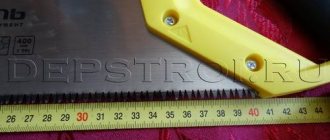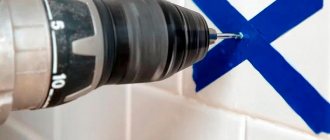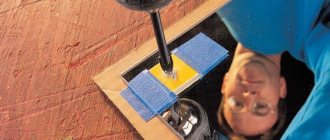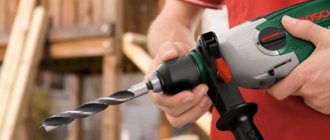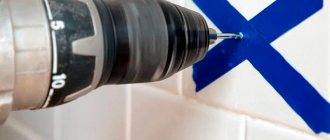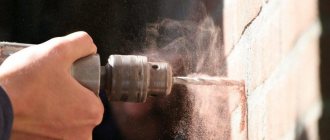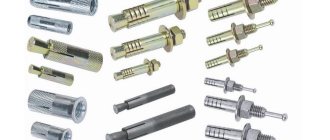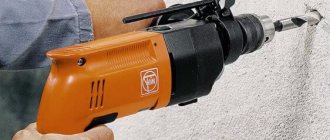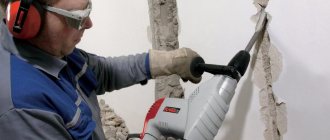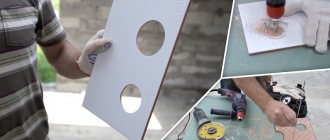Rare repairs can be done without drilling into the walls. If they are made of brick, it is important to familiarize yourself with how to carry out such manipulations before starting work.
Before drilling into a brick, you need to select a tool. The most common options are a drill and a hammer drill. The latter is a professional device, which means that with its help you can cope with the task in a shorter time. If you plan to use a drill, then the main thing for it is to choose the right drill.
Methods for drilling bricks
Drilling a brick wall can be done in one of three ways:
- manual work method;
- electromechanical tools;
- using automatic drilling technology.
The first method is the simplest, but less technologically advanced. It is used if the master does not have the appropriate equipment. Electromechanical technology allows drilling to be completed in a shorter time. For this purpose, a hammer drill or drill is used. As for automatic drilling, it can be used to make holes of impressive diameter - up to 110 mm.
Manual drilling method
Drilling holes in a brick wall using this technology is carried out if there is no electrical equipment. All you need is a hammer and a bolt. The latter is a metal tube that you can make yourself or purchase ready-made. If you resort to the first solution, you will need to prepare a 30 cm piece. The diameter of such a device should be 25 mm or more. Notches are made at one end.
The technology suggests itself if you imagine these tools: once the location for making the recess has been determined, the bolt is installed at a right angle to the wall, and its other end should be struck with a hammer. The bolt rotates, which will prevent the formation of large amounts of dust.
Electromechanical drilling technology
In order to drill a wall in a shorter time, you should use technology that requires the master to have a drill or hammer drill. In the first case, you need to make sure that the equipment has a shock function. Otherwise, you will have long and monotonous work, which, among other things, may not allow you to achieve a positive result.
The ease of the process will depend on the number of revolutions and power of the tool. The most suitable value for the number of revolutions is considered to be 2000 or more. With an increase in this parameter, you can count on the fact that the hole can be made in the shortest possible time. If you are just planning to purchase a drill, it is important to make sure that it has a keyless chuck and a reverse function. In the first case, you do not have to additionally use a clamping wrench.
Drilling can be done right through the brick. For this purpose, a hammer drill with diamond bits is often used. The working part of the equipment must have rounded edges. This equipment should also have an impact option. In order to avoid placing a large load on the hammer drill and consumables when it is necessary to make holes of impressive diameter, you should start with small drills and finish the work with large ones.
If you have warm ceramics or hollow products, you need to turn off the impact function, as this may destroy the material. If the brick has a high grade and good strength, which also applies to clinker products, the electrical device is set to medium speed, otherwise the equipment may become dull.
Attention! If the wall needs to be drilled for installation of a hood, socket or plumbing system, diamond drilling should be used. For this purpose, a crown with especially strong teeth is selected. If used with the tool in impact mode, it may cause the base to be torn out. In order to eliminate such a nuisance, you need to start drilling from the masonry seam.
Automatic brick drilling
If you need to drill a brick wall in a hard-to-reach place, for example, in a corner, or you need to make a recess of impressive diameter, ordinary tools will not help. Here you should use automatic technology, which involves the use of special installations.
Typically, the process involves crowns with a diameter of 2 cm or more. The drilling depth can reach 4 m. This technique is good because it is silent, and 1 cm of thickness can be overcome in a few tens of seconds. To operate such equipment, you need water and an electrical connection. The tool is fixed on a vertical surface, then water is supplied to the drilling site. The work is carried out automatically without human intervention.
Advantages of impact drilling machines for concrete
List of advantages of this class of tools:
It is very convenient that after use the device can be put back into the case with which it was sold.
- autonomy and the ability to hold a charge for a long time (for models without a mains cable);
- easy drilling of durable materials;
- drilling speed adjustment;
- energy intensity and power, represented by varieties for each specific type of work;
- safe use due to low voltage even in wet conditions and in open areas of the construction site;
- the ability to work in hard-to-reach places and remote from communications;
- storage in a special case.
The main parameter that characterizes the device when choosing is the power with which it operates and the number of drill rotations per minute. The higher the number of revolutions, the better.
Drilling tool
If you're wondering what to use to drill into a brick wall, there are several options to consider to decide which one is right for you. The simplest method is mechanized, which involves the use of a hammer and a bolt. This work algorithm will not allow large-scale work to be completed, but if there is only one hole, this approach will be ideal.
A more technologically advanced method compared to manual drilling is the electromechanical method. Here you can’t do without a drill, or, at a minimum, or at a maximum, without a hammer drill. It is better if the drills and augers are new, then the work will go faster. But diamond drilling of brick walls is usually carried out by professionals. It usually does not produce dry dust, but the work area will still require cleaning. The thing is that diamond drilling is accompanied by cooling of the equipment with water. However, only specialists can cope with such a task.
Attention! If you plan to drill brick walls yourself using electric household tools, you need to not only mark the hole, but also core the future hole. This will prevent the drill from slipping.
Selecting and purchasing a drill
The diameter of drills for making holes in brick usually varies from 6 to 8 mm. This value is average, as is the depth, which is usually 15 cm. To make holes with more impressive parameters, it is better to use a drill. Its length reaches one meter, but it is used in conjunction with a drill and a hammer drill. The first one must have the function of a hammer drill.
When there is a thick wall, it is better to act in several approaches. To begin with, a 20-centimeter drill is used, and the recess is approximately 15 cm. Then the depth should be increased to 40 cm, and at the final stage - to 50 cm. During this process, a hammer drill will be needed.
Attention! The presence of an outlet on the wall will help identify and naturally not affect communications. If you don’t have the appropriate equipment at hand with which you can find out whether the wires are running inside, you can follow the first recommendation. But the electrical wiring must be de-energized in any case.
How to make a hole in a brick wall
Before drilling into a brick wall, you need to check for electrical wiring. Then marking is carried out. You need to decide on the parameters of the recess. Depending on this, drills, drills or crowns will be selected.
Preparing tools
If you plan to use a drill, its power should not be less than 600 W, and the number of revolutions should be approximately 2500 or more. Make sure the equipment has a reverse function so you can adjust the power. Brick is resistant to static loads, so the equipment must have an impact option.
The material should be influenced dynamically, only then will it be possible to achieve results. This is why a household drill is not suitable for the process. If you still decide to take a risk and use such a device, you may be faced with the need to repair the drill, since its motor will certainly overheat and fail.
Preparatory work
In addition to electrical wiring, there should be no fittings in the wall. To find it, you should use a metal detector. If there is no tool to find the wiring, you need to make sure that it does not pass through the seams under the layer of plaster. To do this, before starting drilling, you need to deepen the seams a little.
Drilling holes in a brick wall
To make an even recess, you need to install the drill perpendicular to the wall. First, several short inclusions are made so that the equipment deepens a few millimeters. Next, you should begin the main process, removing the drill from time to time and allowing the drill to rest a little.
Preparation of the workplace
Before drilling, you need to prepare your workspace.
Determine where the holes will go, mark the axial point, mark the circle.
It is recommended to study what the walls are made of. Often, during the construction of multi-story buildings, the space inside the walls is used for laying pipes, wires, and reinforcing bars.
In the absence of such data, you should buy a construction metal detector and a wiring indicator. They will help you get the job done quickly, without damaging the structure or the tool.
Sometimes the wiring is carefully laid between the joints of bricks and covered with putty on top. Therefore, it is recommended to make small holes in the seams at the site of the potential opening.
Useful advice from professionals
If you have a solid wall, it is better to choose a pobedit drill. Only it can cope with particularly durable material and not wear off completely. Such equipment lasts longer, and can be used even after that.
In everyday life, 15-centimeter drills are usually used, but on sale you can also find auger drills, which have impressive dimensions and are suitable for hammer drills.
How to make a hole without defects
In order to avoid unpleasant consequences, you need to make sure that there is not only electrical wiring in the wall, but also water and sewer pipes, which are often hidden in the masonry. The presence of electrical wiring can be indicated by a socket on the wall; wires from it run to the switch.
How to drill without dust
If the room is already finished, such a need may arise. If the electric tool you are using does not have a connection pipe for connecting a vacuum cleaner, you can use the help of a second person who will remove dust as soon as it begins to spill out of the new hole, leaning the suction tube against the recess. If you work independently, you can place something like a shelf at the point of impact on the wall, where all the dust will fall.
Creating a Niche
If you plan to drill a recess larger than 20 mm or need to create a niche for a socket, you should purchase a Pobedit drill bit. Multiple holes are made along the intended line, the jumpers between which are then removed using a chisel and hammer. An alternative and more technologically advanced solution would be to use a hammer drill and a crown together with it.
Answers from forum users and experts to the question: How to drill brick?
You can drill with a conventional drill using Pobedit carbide brazing on the drill. You can also try with a hammer drill (if you have one), but it will make larger holes, so you should take a narrow drill. You can also use a tile drill. To avoid having to constantly remove the drill from the chuck to remove dust, take a longer drill.
Was the information useful?
Answer or clarify the question
Subscribe to a forum topic
Popular questions
The saw does not maintain idle speed and does not pick up speed; it runs almost uniformly
How to glue tiles to a clay wall?
How to organize the production of foam blocks?
I have a terrible view of the wooden house from the inside. Therefore, I plan to do the interior cladding of the house. Tell me what it is.
I want to cover the imitation pine timber on the façade with materials from the company Biofa
first antiseptic primer, glaze 2 layers, oil. The seller suggests tinting the oil as this is the last layer and it is the one that should be tinted, so they say. question.
What is the cost of building a one-story house made of timber?
I decided to build a one-story house from timber, but I’m just starting to collect money for this construction. Tell me, how much do I need to collect?
Interior of a chic white kitchen
If you have a huge kitchen space, then this is what it should look like. Don’t be intimidated by the abundance of white: it makes this kitchen look chic and fresh. White.
